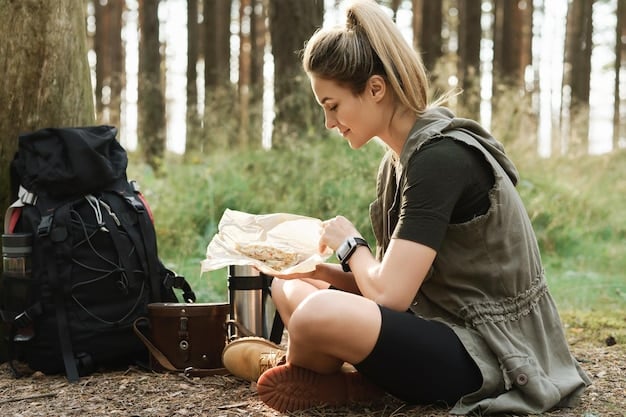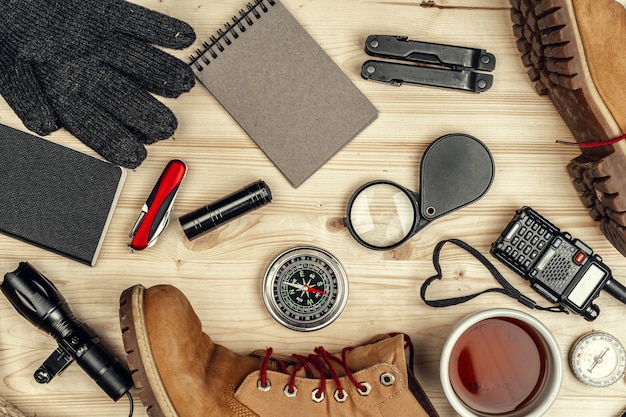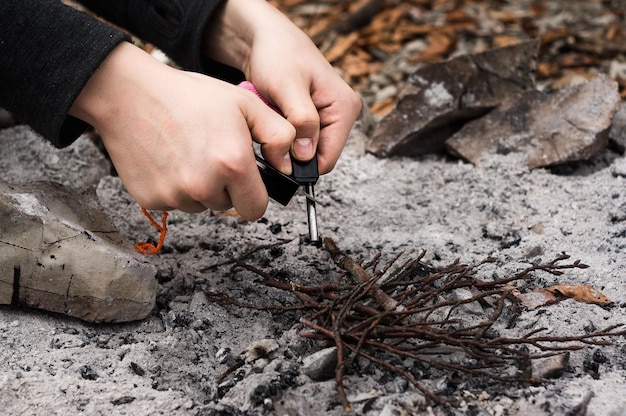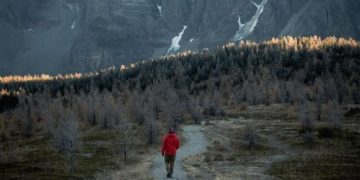Wilderness Survival Skills: Your Guide to Outdoor Safety

Mastering wilderness survival skills involves acquiring essential knowledge and practical techniques to navigate and respond effectively to unexpected challenges in remote outdoor environments, ensuring personal safety and well-being.
Embarking on an outdoor adventure offers unparalleled experiences, but the wilderness can be unpredictable. Understanding Wilderness Survival Skills: A Comprehensive Guide to Staying Safe in the Great Outdoors is not just for extreme adventurers; it’s vital for anyone venturing beyond paved roads. Equipping yourself with these foundational abilities transforms potential hazards into manageable situations, ensuring you not only survive but thrive amidst nature’s challenges.
Understanding the Core Principles of Survival
Survival in the wild hinges on a proactive mindset and a deep respect for the environment. It’s not about conquering nature but about understanding its forces and adapting. The core principles revolve around planning, preparation, and the ability to improvise. Approaching any outdoor excursion with these tenets in mind significantly increases your chances of a safe and enjoyable experience, even when faced with unforeseen circumstances.
One of the initial steps involves self-assessment: understanding your physical and mental limitations before pushing boundaries. Realistic self-awareness prevents overestimation in challenging situations, a common pitfall. Moreover, developing a keen sense of observation allows you to interpret subtle environmental cues, which can be critical for predicting weather changes or identifying potential resources.
The Rule of Threes in Survival
The “Rule of Threes” is a foundational guideline in survival, emphasizing what you can endure in extreme conditions:
- Three minutes without air: This highlights the immediate threat of suffocation, often due to injury or environmental factors.
- Three hours without shelter in extreme conditions: Hypothermia or hyperthermia can set in rapidly, making shelter a top priority.
- Three days without water: Dehydration impairs cognitive function and physical ability, stressing the urgency of finding potable water.
- Three weeks without food: While uncomfortable, the human body can go surprisingly long without food, making it less immediate than other needs.
These benchmarks prioritize your actions in an emergency. They underscore that while food is important, securing shelter and water are far more critical for immediate survival. This hierarchy dictates where your energy and attention should be focused if an emergency arises, from the initial moments to extended periods.
Beyond these immediate physical needs, mental fortitude plays an equally crucial role. Maintaining a positive attitude, the will to survive, and the ability to think clearly under pressure can often be the deciding factor between rescue and despair. Panic is the enemy of rational thought; therefore, practicing calm under simulated pressure is as important as any physical skill.
Ultimately, comprehensive survival training integrates these physical and psychological elements. It’s about building resilience and resourcefulness, not just acquiring a set of techniques. The wilderness respects preparedness, and those who approach it with a well-rounded understanding of these core principles are inherently safer.
Essential Gear and Preparation for Any Expedition
Proper gear is the bedrock of any successful outdoor adventure and becomes even more critical in a survival scenario. It’s not just about packing a lot of items, but packing the right items, chosen for their multi-functionality and reliability. A well-prepared backpack can genuinely be a lifeline, supporting basic needs and facilitating self-rescue or prolonged waiting for help.
Before you even step foot outside, a thorough trip plan is paramount. This includes researching the terrain, understanding expected weather patterns, and identifying potential hazards unique to your destination. Share your detailed itinerary with a reliable contact, including your expected return time. This simple step ensures that if you don’t check in, someone knows where to start looking.
The Ten Essentials
Modern outdoor enthusiasts often carry the “Ten Essentials,” a system of key items that help you prepare for common wilderness emergencies:
- Navigation: Map and compass (and the knowledge to use them), often supplemented by a GPS device or smartphone with appropriate apps.
- Headlamp/Flashlight: Crucial for visibility after dark, especially for setting up camp or navigating unexpected delays.
- Sun Protection: Sunglasses, sunscreen, and protective clothing to guard against UV radiation.
- First Aid: A comprehensive kit tailored to potential injuries and personal medical needs.
- Knife/Multi-tool: Indispensable for countless tasks, from cutting cordage to preparing food.
- Fire Starter: Waterproof matches, lighter, or a ferrocerium rod to build essential fires for warmth, cooking, and signaling.
- Shelter: Lightweight tarp, emergency blanket, or bivy sack for immediate protection from the elements.
- Extra Water/Water Filter: Ensuring hydration is critical; a filter allows resupply from natural sources.
- Extra Food: Non-perishable, high-energy snacks for unexpected delays or an unplanned overnight stay.
- Extra Clothes: Layers appropriate for the climate, including a waterproof outer layer.
Beyond these essentials, consider the specific nature of your trip. Are you hiking in a desert? More water is needed. Are you exploring a cold, mountainous region? Insulated layers are paramount. Customizing your gear list based on the environment reduces unnecessary weight while optimizing utility. Prioritize quality and familiarize yourself with how to use each item under stress.

Packing efficiently goes hand in hand with choosing the right gear. Distribute weight evenly, and place frequently needed items within easy reach. Waterproofing important items like maps, cell phones, and extra clothing against rain or accidental submersion is also a smart practice. Ultimately, preparation involves thoughtful planning, diligent packing, and a continuous learning mindset to handle anything the wilderness might present.
Navigation and Orienteering Skills
Losing your way in the wilderness can quickly turn an enjoyable outing into a perilous situation. Therefore, proficient navigation and orienteering skills are perhaps among the most critical survival abilities. Relying solely on GPS or smartphone applications is risky; batteries can die, signals can drop, and devices can fail. The timeless tools of a map and compass remain essential, providing a reliable backup and a deeper understanding of your surroundings.
Learning to read a topographic map is foundational. These maps provide detailed information about terrain features, elevations, water sources, and trails. Understanding contour lines, symbols, and scale allows you to visualize the three-dimensional landscape in a two-dimensional format. This skill helps in planning routes, identifying potential obstacles, and finding safer paths, especially when off-trail.
Using a Compass Effectively
A compass, when used with a map, becomes an incredibly powerful navigation tool. It allows you to orient the map to your surroundings, take bearings to distant landmarks, and follow a specific direction even when visibility is limited. Mastering its use involves:
- Orienting the map: Aligning the map’s north meridian with magnetic north using the compass.
- Taking a bearing: Determining the direction from your current position to a specific point on the map or in the landscape.
- Following a bearing: Walking in a straight line towards a distant point, maintaining the compass bearing.
- Triangulation: Using two or more distinct landmarks to pinpoint your exact location on the map.
Practice is key to building confidence with these tools. Start in familiar parks and gradually move towards more challenging terrain. Regularly cross-referencing your map and compass with your surroundings trains your mind to integrate these pieces of information, leading to better situational awareness. Observing natural cues, such as the position of the sun, star patterns, or even moss growth on trees (though this can be unreliable), can provide secondary navigational clues.
Even with advanced GPS devices, understanding how to use a map and compass is non-negotiable. It provides a deeper connection to the land and a fundamental skill set that requires no power source. In a true survival scenario, when modern technology fails, these traditional methods are what will guide you back to safety. Continuously refining these skills ensures you are never truly lost, only temporarily disoriented.
Shelter Building and Fire Starting
When an unexpected overnight stay becomes inevitable, having the knowledge to construct a rudimentary shelter and start a fire can be the difference between comfort and severe hardship, or even survival. These skills directly address the Rule of Threes, providing protection from the elements and a means for warmth, cooking, and signaling.
Shelter provides a barrier against wind, rain, snow, and sun, helping to regulate body temperature. The type of shelter you build will depend on the resources available and the climate. Simple options include a lean-to using branches and leaves, a snow cave in winter environments, or even enhancing natural depressions or rock overhangs. The goal is to minimize heat loss (or gain, in hot climates) and provide a dry space. Always consider the ground insulation; a layer of leaves or pine needles can significantly improve warmth.
Mastering Fire Starting Techniques
Fire serves multiple critical functions in a wilderness survival situation:
- Warmth: Prevents hypothermia and maintains core body temperature.
- Cooking and Purification: Sterilizes water and cooks food, making it safe for consumption.
- Drying Clothes: Helps to dry wet clothing, preventing further heat loss.
- Pest Repellent: Smoke can deter insects and some animals.
- Signaling: A smoke signal during the day or a bright flame at night can attract rescuers.
- Psychological Boost: The comfort and light from a fire can greatly improve morale.
While a lighter or waterproof matches are ideal, knowing how to start a fire by friction (bow drill or hand drill) or with a ferrocerium rod is a valuable backup skill. Regardless of the method, fire starting requires three key components: tinder (easily ignitable material like dry grass, birch bark, or cotton balls), kindling (small twigs), and fuel (larger branches or logs). Preparation is vital; gather all your materials before attempting to light the fire, ensuring they are dry and readily available.

Practice these skills regularly, even if it’s just in your backyard. Being able to quickly and efficiently build a stable shelter and ignite a fire can drastically improve your odds when faced with an unexpected night in the wild. These are not just physical tasks but also mental challenges that require patience, observation, and adaptability. The more proficient you become, the more confident you will feel venturing into remote areas.
Water Procurement and Food Foraging
Next to shelter and fire, access to safe drinking water and, in longer-term scenarios, caloric intake, are paramount for survival. Dehydration can rapidly debilitate an individual, impairing judgment and physical capabilities. While the human body can endure weeks without food, it can only last days without water, making water procurement a higher priority in most short-term survival situations.
Identifying potential water sources is the first step. Look for natural depressions, green vegetation (indicating shallow groundwater), or follow animal tracks, which often lead to water. Rainwater collection can be highly effective, as can dew collection in the morning. When water is found, purification is critical to avoid waterborne illnesses. Boiling water for at least one minute is the most reliable method, but portable filters, purification tablets, or solar stills can also be effective alternatives.
Safe Foraging Practices
While food isn’t an immediate survival concern for short periods, being able to identify edible plants and insects can provide valuable nutrition and boost morale if a situation extends. However, foraging carries significant risks due to poisonous look-alikes. The universal edibility test is a slow and cautious method, but it is not infallible. It’s far safer to rely on well-researched knowledge of local flora and fauna. If in doubt, do not eat it.
- “Leaves of three, let it be”: Refers to poison ivy, poison oak, and poison sumac.
- Avoid unknown mushrooms: Many are poisonous and can be deadly; only consume if 100% certain.
- Consider insects: While unappetizing to some, many insects are a good source of protein. Avoid brightly colored insects.
- Fish & Game: If you have fishing line or snares, small game and fish can provide substantial sustenance, but require additional skills in trapping and preparation.
- Berries and Nuts: Some are excellent food sources, but again, positive identification is crucial.
Before any trip, familiarize yourself with the common edible and poisonous plants of the region you will be visiting. Carry a reliable field guide if possible. Remember that food gathering requires energy, so weigh the caloric expenditure against the potential gain. Often, conserving energy is more beneficial than expending it on risky or low-yield foraging efforts. Prioritize water and maintaining core body temperature before dedicating significant effort to sourcing food.
Developing these skills requires cautious practice and careful study. Never experiment with unknown plants in a real survival situation. Your ability to safely secure water and, if necessary, identify safe food sources, fortifies your overall survival strategy, turning scarcity into sustenance.
First Aid and Signaling for Rescue
Even the most prepared adventurer can encounter an injury or medical emergency in the wilderness. Knowing basic first aid and effective signaling techniques can be the difference between a treatable situation and a dire outcome. A comprehensive understanding of wilderness first aid prepares you to manage injuries ranging from minor cuts to life-threatening trauma, far from immediate medical care.
Carry a well-stocked first aid kit tailored to the likely risks of your destination. This should include bandages, antiseptic wipes, pain relievers, blister treatment, and any personal medications. Knowing how to use these items is paramount. Basic first aid training, such as CPR, wound care, splinting, and treating hypothermia or heatstroke, is invaluable. Remember the acronym R.I.C.E. (Rest, Ice, Compression, Elevation) for sprains or strains, and the importance of staunching bleeding immediately.
Effective Signaling for Rescue
Once you are stable and injuries are managed, signaling for rescue becomes the top priority. The goal is to make yourself as visible and audible as possible to potential searchers. Effective signaling techniques include:
- Whistle: Three short blasts repeated regularly is a universal distress signal. A whistle carries farther than the human voice.
- Mirror/Reflective Surface: Using a signal mirror to flash light at passing aircraft or distant vantage points, three flashes per burst.
- Fire/Smoke: A large, controlled fire at night, or a smoke signal (using green branches or wet leaves on a fire) during the day, especially in open areas.
- Ground-to-Air Signals: Creating large patterns on the ground visible from above, such as an “X” for medical emergency or “V” for require assistance.
- Bright Clothing: Wearing brightly colored outer layers can make you more visible in varied terrain.
Always stay put if you believe rescuers are looking for you. Do not wander aimlessly, as this complicates rescue efforts. Choose a location that offers both shelter and visibility for signaling. Conserve energy and resources while maintaining a positive outlook. Even small actions like keeping your fire going or periodically blowing your whistle can significantly increase your chances of being found. Knowing that you have practiced these skills provides significant psychological comfort and boosts your confidence in a crisis.
The ability to provide self-care and communicate distress effectively represents the culmination of wilderness survival knowledge. It ensures that in addition to navigating immediate threats, you are also actively working towards your ultimate egress from the situation. Regular refreshers on first aid and signaling techniques are highly recommended for any outdoor enthusiast.
Mental Fortitude and Problem Solving
While physical skills and appropriate gear are undeniably important, the psychological aspect of wilderness survival often proves to be the ultimate determinant of success. How one’s mind reacts to stress, fear, isolation, and uncertainty can make or break a survival situation. Cultivating mental fortitude and effective problem-solving abilities is as crucial as any practical skill.
Panic is arguably the greatest enemy in a survival scenario. It clouds judgment, leads to irrational decisions, and drains precious energy. The first step upon realizing you are in trouble is to stop, calm down, think, observe, and plan (STOPS). Taking a few deep breaths, assessing the situation logically, and focusing on immediate, actionable steps can prevent a downward spiral. Break down overwhelming problems into smaller, manageable tasks.
Cultivating a Survival Mindset
A positive mental attitude (PMA) is a recurring theme in survival narratives. Believing in your ability to survive, maintaining hope, and fighting against despair fosters resilience. This isn’t just wishful thinking; it translates into proactive behavior and the persistence required to overcome obstacles. Key aspects include:
- Adaptability: Being able to adjust plans and techniques based on changing circumstances and available resources.
- Resourcefulness: Using what you have in creative ways; for example, a plastic bag can be a water collector or a makeshift glove.
- Patience: Many survival tasks, from fire starting to patiently waiting for rescue, require significant patience.
- Observation: Continuously observing your surroundings for resources, hazards, and potential signs of rescue.
Problem-solving in survival often involves iterative trial and error, coupled with critical thinking. Instead of fixating on a single solution, think about multiple approaches. For example, if your primary fire-starting method fails, what’s your backup? If one shelter location isn’t suitable, where else could you build? This flexibility prevents stagnation and encourages continuous effort.
Moreover, combating negative self-talk and focusing on small victories can maintain morale. Remind yourself of your training and the purpose of your actions. Psychological tricks, like setting small, achievable goals (e.g., collecting enough firewood for two hours, finding twenty minutes’ worth of kindling), provide a sense of accomplishment and forward momentum. Ultimately, true survival is a testament to the human spirit’s ability to endure and adapt, making the cultivation of mental resilience an indispensable component of any wilderness skill set.
| Key Skill | Brief Description |
|---|---|
| 🧭 Navigation | Mastering map & compass use prevents getting lost and guides safe routes. |
| 🔥 Fire & Shelter | Essential for warmth, cooking, and protection from harsh elements. |
| 💧 Water & Food | Prioritizing hydration and identifying safe, available sustenance. |
| ⛑️ First Aid & Signal | Administering immediate medical care and signaling for rescue. |
Frequently Asked Questions About Wilderness Survival Skills
▼
While many skills are crucial, mental fortitude and the ability to stay calm under pressure are often considered the most important. Panic can lead to poor decisions, whereas a clear mind allows for effective problem-solving and application of other learned skills. This psychological resilience underpins all practical techniques in a survival situation.
▼
The most reliable method is boiling water vigorously for at least one minute, which kills most pathogens. Other methods include using chemical purification tablets, portable water filters, or building a solar still. Always filter out large particulates first using a cloth before applying any purification method to ensure better results and equipment longevity.
▼
The “Ten Essentials” are a widely accepted list: navigation (map/compass), headlamp, sun protection, first aid kit, knife, fire starter, emergency shelter, extra water/filter, extra food, and extra layers of clothing. These items address common emergencies and help ensure basic survival needs are met in unexpected circumstances.
▼
Effective signaling methods include using a whistle (three short blasts, repeated), a signal mirror to reflect sunlight, building a large signal fire (especially at night) or creating a smoke signal (daytime), and creating ground-to-air signs like a large “X.” Staying put and conserving energy are also critical for rescue.
▼
While formal courses provide structured learning, many skills can be learned through self-study (books, reputable online resources), practice, and mentorship. However, hands-on practice in a safe environment is crucial. Some complex skills, like advanced first aid or precise navigation, benefit greatly from expert guidance and real-world application.
Conclusion
The pursuit of wilderness survival skills is an empowering journey that transforms how we interact with the natural world. It’s an investment in preparedness, fostering self-reliance and broadening one’s appreciation for nature’s intricacies. By embracing these essential techniques, from navigation to mental resilience, every outdoor enthusiast can venture forth with greater confidence, ensuring that adventures remain safe, enriching, and memorable, regardless of unforeseen challenges.





